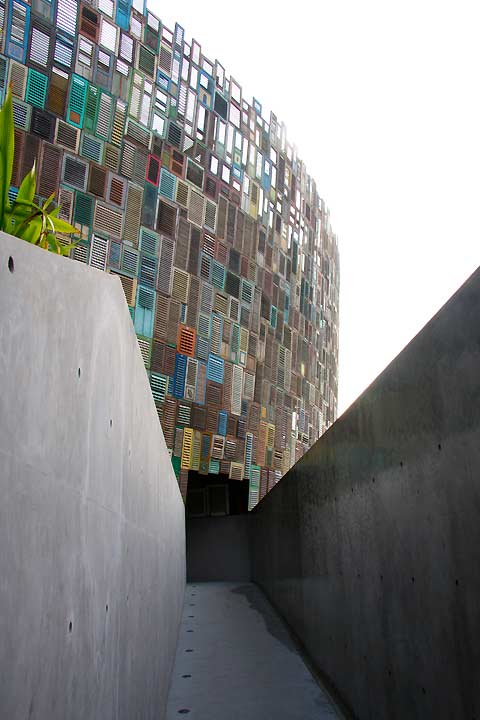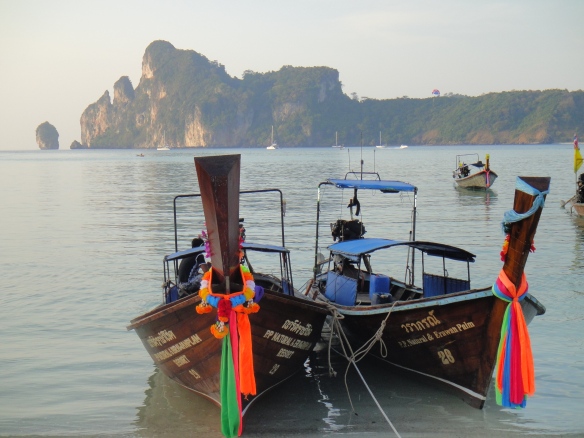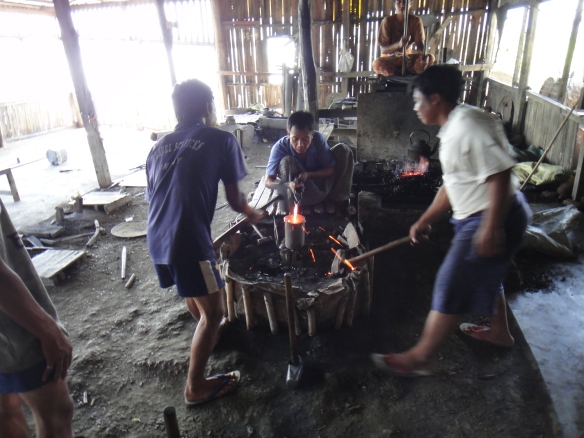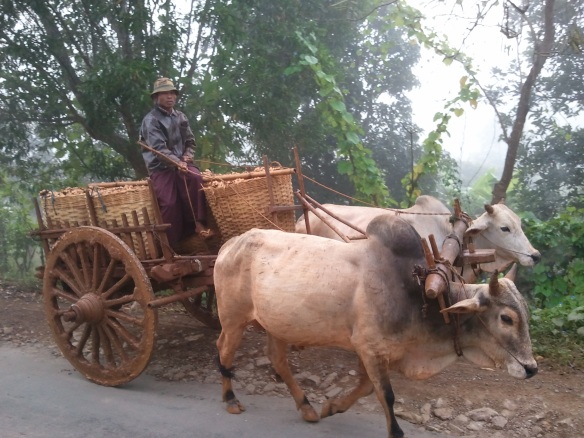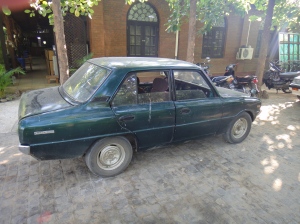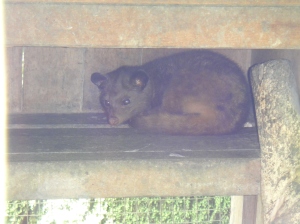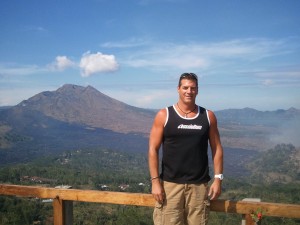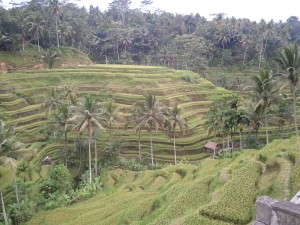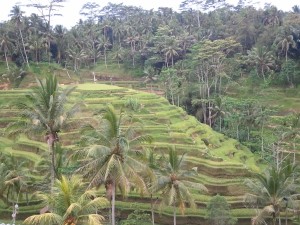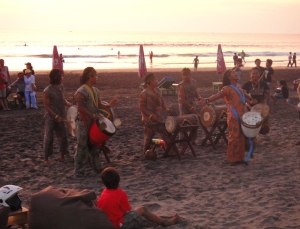I’ll start this post with a few notes to better explain some of the context and pictures for the rest of the trip. First, the men here all wear longyis (pronounced “lon-jees””), which are similar to sarongs that go all the way down to their ankles. Women also wear similar longyis, or skirts. You very rarely see any local people in pants or shorts. I didn’t wear a longyi, but you may see the local people in my pics wearing them. You’ll also see pictures of women with splotches of tan “paint” on their faces. It’s sort of make-up, but moreso sunscreen. They take the root of some tree, grind it into a powder, mix it with water into a thin paste, and brush it on their cheeks and sometimes forehead and nose.
Second, I make references to my “guide” and “driver”. Although you can technically tour around Myanmar on your own, it’s very difficult to do so. It’s not like most other Southeast Asian countries where you can easily book flights, hotels, etc. online. You can’t really book anything online here. Also, most of the signs at the tourist areas are written in Burmese, and most of the local people don’t speak English so you really need someone to help translate for you. Given this, the vast majority of people book tours where you have a guide and a driver in each town that you visit, or in some cases you book a single guide that travels all around the country with you. I went for the former, so had a different guide and driver in each town.
The last point is that when visiting Buddhist temples/pagodas/stupas, you’re not allowed to wear shoes or socks, so in the pics of me at those places you’ll see I’m always barefoot (and frankly, although I love wearing flip-flops, going barefoot is even better!).
Some quick terminology: A “stupa” is a structure, usually bell-shaped, that is just a monument – it does not have entrances or any way to go inside it. Often times, stupas will have some symbolic Buddhist thing built into them (i.e., a lock of Buddha’s hair, a ruby that was touched by Buddha, etc.). A “temple” is a structure where you can go inside. Temples most often have one or more Buddha statues inside, and these are where people go to pray, give offerings, ask for advice from the spirits, or ask for health/luck/safety/etc. Temples can be standing on their own, or they often are also built around the grounds of a stupa. Lastly, “pagoda” is kind of a generic term that refers to either a stupa or a temple. You’ll see me use all three terms in my writing, although mostly I just use the generic stupa term.
Bagan
After a day in Yangon, I flew to Bagan. Bagan is kind of in the central part of Myanmar, in a river valley between two mountain ranges. It is primarily known for its vast area of ancient pagodas. It’s basically an archeological site that was excavated fairly recently (1970’s, I believe). In a 60 square mile area, there are over 2000 pagodas! They were built between the 9th and 12th centuries and vary in size from massive ones 300+ feet high, to small ones the size of a dog house, and every size in between. The largest ones were built by previous kings, while the smaller ones were built by people living in the area – the more wealthy you were, the more bricks you could buy, and the larger the pagoda you could build. Most of them were built with bricks, although there are a few that were built out of sandstone that was quarried from nearby mountains and floated on boats down the river. You can’t look in any direction in Bagan without seeing at least a dozen pagodas… they literally are everywhere.

Me at a local market in Bagan

Me at Shweziko Pagoda

Me in front of one of the zillion Buddha statues in the temples of Bagan. This was actually a relatively small statue compared to many of them.

A small fraction of the thousands of pagodas

30-foot high Buddha statue
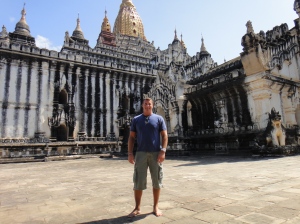
Me in front of one of the temples
We spent the whole first day touring what seemed like all 2000+ pagodas. Actually, we went to about 8 or 10 of them, and each was a little different and interesting to see. The Buddha statues in some of the temples were amazing, and the smell of incense in them from the local people there praying was overpowering. The locals bring “offerings” to the Buddha statues when they pray, and the offerings are typically a bowl of fruits, money, water, incense, or flowers. It’s pretty cool to see the piles of bananas and flowers and money just laying around from people that have given it as offerings.

Women praying and giving offerings at a temple

A lot of people -- both tourists and locals -- use these horse-drawn carts to get around thru the dirt roads among the pagodas.
We also went to a couple of ancient monasteries. These were similar to some of the temples, although they were just one level, had no windows, and were just some corridors with small rooms where the monks would meditate and pray for hours/days/weeks at a time. It felt a bit like being in a bomb shelter or bunker inside… but I suppose if you’re meditating for that long, you don’t want a lot of distractions so it probably served their purposes well.

This was the largest pagoda in Bagan...and it was truly awesome!
At the end of the day, we went to a tall temple that you could climb nearly-vertical stairs on the outside to get to a small platform near the top. It allowed for an amazing panoramic view of the whole valley with the pagodas all around standing out of the grasses and trees. As the sun set, the brick of the pagodas, along with many of the gold towers, almost looked like they were glowing they were so lit up from the sunset.

At sunset from the top of one of the pagodas

Sunset across the temples of Bagan
It was a very peaceful and awe-inspiring way to end the day there. I didn’t think it could get any better. Until the next morning…
Up, Up and Away!
There’s an Australian company that runs a hot air balloon program in Bagan. I had heard about it when researching Myanmar, and signed up for it when I booked my trip. They fly you in a hot air balloon at sunrise over the pagodas. I’ve never flown in a hot air balloon before, but I’ve always wanted to since I was a kid, so I figured there’s no better place to lose my ballooning virginity than Bagan, Myanmar!
They picked me up in an old wooden bus at 5am and we went to the launch site. There were 5 balloons, and each balloon basket has 5 compartments: one in the center for the pilot, and two on each side for passengers. The passenger compartments hold three people each, so with the pilot, there is a baker’s dozen in the basket (it’s so rare in life that I get to use the baker’s dozen reference…I’m so happy right now!). Looking around at the 50 or so other people that were there, it was pretty obvious that I was the youngest person…by at least 20 to 30 years. That was a bit of a shock to me, but hey, old people can be fun sometimes. 🙂
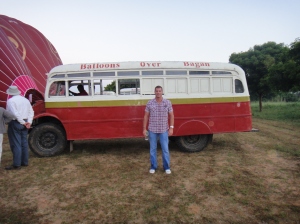
Me in front of the wooden balloon bus. Pretty sweet ride, huh!?
We split into groups of three for our compartment assignments and I was with a retired couple from the UK. The wife was Scottish, and they live in Bath, England. When I told them I had actually been to Bath back in 1993 (to give several presentations at a Microsoft conference there), we had an instant bond. But the old Scottish lady (well, she wasn’t that old, but I’m going to refer to her with that name) had to do one better than me, so she proudly proclaimed that she not only had been to Seattle, but she’s also seen the movie “Sleepless in Seattle”, as well as watched every episode of “Frasier” on TV. While I hate being upstaged like that, I was starting to like the old Scottish lady…
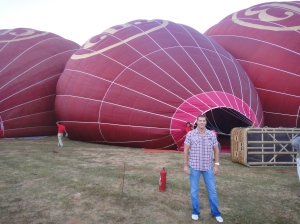
Balloons half-way inflated
We took off from the launch site just as the sun was coming over the mountains. We went up to a height of 2000 feet, and it was a stunning sight to see the thousands of pagodas as the sun was just beginning to shine on them. Throughout the valley, you could see small trails of smoke from villages and huts where they were starting their morning fires for cooking. You could also see the morning fog that stays low to the ground and kind of forms rivers of mist through the trees…beautiful! We dropped down low, just above the tree line, and drifted there for a while to get a close-up view of several pagodas as we passed by them, then went back up a bit to see more of them. It was such an amazing experience! It was worth every penny that it cost, and definitely worth getting up at 4am for!
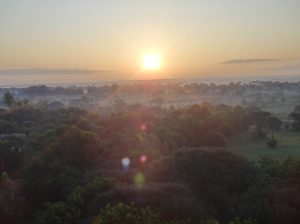
On our way up... just clearing the tops of the trees
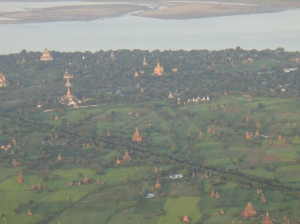
Birds-eye view from the balloon of pagodas and the river beyond

Two of the other balloons in our group as the sun is coming up

More pagodas as seen from the balloon

Balloons passing by the pagodas

Another view of hundreds of the pagodas with the river in the background
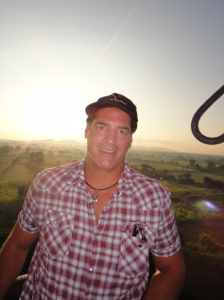
Dorky pic of me in the balloon. They had us wear these goofy hats because the flames from the burner were crazy hot...enough to scorch your hair.
The pilot picked a landing spot, which was a patch of dirt in some small shrubs. The ground crew was there, and as soon as the village kids saw where we were landing, they all started running through the trees to come meet us and watch the balloon land. I’m sure they’ve seen it a hundred times before, but man were those kids giddy with excitement!

Celebrating a successful balloon flight with a glass of champagne!
The Old Scottish Lady
After landing, we had about an hour to wait while they deflated the balloon and packed it up. They had champagne for us, and we all stood around talking. The old Scottish lady had been asking me about my travels, why I travelled alone, whether it was safe, etc. She then said their son is in his final year of university, and wants to take a year to travel around the world when he’s done. She was petrified about his safety and said she didn’t think they were going to let him go, and asked what I thought. Well, since she asked for my opinion, I gave her an earful. I told her if I had children, I would *require* that they take a year to travel the world after college. I’ve learned so much from travelling, been humbled beyond belief, realized how lucky I was to be born in a family and country that allowed me to make a good living, had some of the best experiences of my life, and met some fantastic people along the way. A lot of that just can’t be taught, and I couldn’t imagine depriving my kids of that life experience now that I know what’s out there.
She was worried about her son getting sick, especially because he has a peanut allergy. I told her that yes, he was likely going to get food poisoning, will probably get exposed to peanuts and have an allergic attack, will probably end up in the hospital at some point, but that’s all part of the experience and she’d be doing him more harm than good by not letting him go. I also inferred that she was being a bit hypocritical, since she had told me that right after she finished university, she moved to Tokyo to teach school for two years, and while there did some travelling through Asia. After a lot of discussion, she had pretty much changed her mind and I had sold her on the plan. By that point, I was really liking the old Scottish lady, and her son owes me a huge thank you.
We had both finished our glasses of champagne, and she said “Ya know, I think I saw where they stashed the rest of the champagne. I’m gonna go get me another glass… you look like you could use another hit too.” Now I think I’m starting to really love the old Scottish lady! So we tracked down the champagne and topped up our glasses. Then the conversation shifted to me, and she asked why I was still uncertain about moving over here, etc. After a lot more discussion, she said “Gary, it’s obvious from everything you’ve told me that your soul belongs here… you were meant to be in Asia. But you’re just too damn scared to admit it to yourself.” Ok, shut up old Scottish lady, I don’t think I like you anymore…
We had a good discussion the rest of the way home on the old wooden bus and parted ways when they got to their hotel. Aside from an astounding morning of ballooning, I had a ton of fun talking with the old Scottish lady.
On To Mount Popa
After ballooning, the guide picked me up at my hotel and we were going to Mount Popa. It’s an extinct volcano, which rises about 3000 feet, and the center “plug” of the volcano stands by itself and there’s a pagoda on top of it. It’s about a 2 hour drive to get there, and along the way, the scenery changes considerably to a more agricultural setting. The main crops around Bagan are potatoes, onions, cabbage, corn, peanuts, sesame, bananas and a variety of other fruits.
We stopped at a peanut and palm farm along the way. There were women in the field that would stand on a bamboo pedestal and shake a basket of peanut plants. The peanuts would separate from the plant and fall straight down to the ground, while the stalk and plant material would get carried by the wind and fall a little ways away. It was similar to “separating the wheat from the chaff”… interesting to watch. They then showed us how they grind the peanuts with a large wooden pole and stone mill, powered by an ox that walks in circles. I even got to have a turn at riding on the grinder behind the ox. I’m such a farmboy. Lastly they showed us how they harvest palm fruit and palm juice, and how they make candy and alcohol from the palm juice. They basically have a little still set up in the field, and it makes some potent alcohol. On a side note, isn’t it interesting how every culture throughout history has figured out how to make alcohol based on whatever plant/food material they have available to them: corn, rye, wheat, potato, palm…

Woman on pedestal separating peanuts from the stems and plant material

Me grinding peanuts into peanut oil with the help of my trusty ox. I named him Brutus.

A still used to turn palm juice into high-grade alcohol!
We finally arrived at a small village at the base of Mount Popa. There are 777 stairs that lead from the village up to the temple on top, curving around the outside of the volcanic plug. There also are hundreds and hundreds of monkeys roaming around the stairs and generally causing havoc. As with all pagodas, we had to take our shoes off before starting the climb. So not only do I have to climb 777 stairs barefoot, I have to do it while avoiding crazy monkeys as well as all their poo and pee on the stairs. Danger is my middle name, and Mount Popa is my StairMaster workout!

A section of the stairs winding up the pillar to Mount Popa temple
After sweating about three buckets of sweat on the way up, we finally made it to the top. The pagoda was, frankly, nothing spectacular and not that different from the zillion that we’d seen the day before, and certainly not worth climbing all those stairs for. But the view from the top was pretty cool, especially looking down at the houses and village below. And if I’m ever on Jeopardy and Alex Trebek says, “The number of stairs you need to climb to reach the top of Mount Popa”, I can confidently ring in with my buzzer and say “What is 777, Alex?”!

At the top of Mount Popa... then I slipped off the railing and fell all the way back down! No, just kidding...

Another one of me at the temple on Mount Popa, with the village down below

Another one of me at a different area of the temple on Mount Popa. For some reason, this pic makes me think of a scene from "The Sound of Music".
After Mount Popa, we went back to Bagan and he took me to a lacquerware shop. Lacquerware is typically plates, bowls, cups or similar things that are made out of bamboo to get the initial shape, then are coated in 14 coats of lacquer, and each coat has to dry for several months in an underground room away from sunlight and at just the right temperature and humidity. It was interesting to watch the artists make the products there, and they do all of the intricate artwork and designs freehand. I’m not sure who the person was that came up with the 14 layers of lacquer to get it to perfection. I would have probably given up after 10 or so coats. But the finished products do look great and are super sturdy.

Girl working at the laquerware shop
We ended the day by going to another tall pagoda to watch the sunset (different pagoda than the sunset the previous day). Again, it was a stunning sunset across the fields of pagodas, very peaceful, very thought-provoking, and everyone there seemed to be taking in every second of it until the last little sliver of sun went down behind the mountain. Then, of course, it’s pitch black outside and we’re all trying to find our way down the steep stairs of the pagoda (with no handrails) without tripping and falling to our death.

Climbing candle-lit stairs inside the pagoda to get to the top to watch the sunset

Taking in a quiet sunset on top of the pagoda

At the top of the pagoda, goofing around after the sunset
Mandalay
The following morning I had an early flight to Mandalay. Mandalay is a larger city, somewhere between 1.5 and 4.5 million people (I could never get an accurate answer on the population). I only had one day/night there and it wasn’t that exciting, other than our first stop in the morning at a large monastery. The monastery has over 1500 monks living there. They eat breakfast at 5am, lunch at 10:15am, and then are not allowed to eat again until the next morning (although they are allowed to drink water and fruit juice). The public and tourists are allowed to watch the monks get their food and eat, so it was a bit of a tourist thing, but still really cool to see.
We got there about 9:45 and my guide in Mandalay had spent time there as a monk, so he knew the compound well. He showed me the storage areas where they keep all the rice and food, the kitchen where they cook it, the housing areas where the monks sleep, and other random buildings. Anyone reading this should feel very thankful for what you have; those monks live on a pretty meager subsistence.

Kitchen where they cook the large vats of rice for the monks
Right at 10:15, a monk hammered a mallet three times against a big iron bell. Then we watched as 1500 monks formed two lines down the road, and began walking into a courtyard where there were about 12 huge metal vats of rice. Each monk carries their offering bowl with them, and opens it while a server gives them a big helping of rice. They then walk a little further and are given two bananas, then go into the eating room. I don’t know what was so fascinating about watching a seemingly endless line of men with shaved heads and red robes walk down the road, into a courtyard and get a bowl of rice, but it truly was fascinating to watch!

Stirring the vats of rice, getting ready to serve the monks
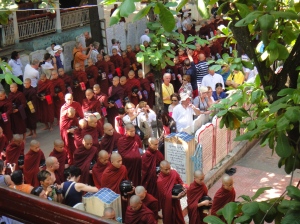
Monks coming down the road for their lunch

Monks getting served their rice
On the tables in the eating area are bowls of various chicken and pork curry that they eat with their rice. We went in and watched them eat. I felt a little weird about it, kind of like watching zoo animals, but all the tourists do it and the monks seem fine with it and were smiling and talking with us before/after eating (but they don’t talk at all during eating). Most of them only eat about half of their food, then bring the rest back for the cats and dogs to eat.

Monks eating lunch
The rest of the day, we went to see a 100 year old, 1 kilometer long teak bridge across a lake (it was about as boring as it sounds), took a cruise on a boat up the river to see some more temples, the world’s largest uncracked bronze bell (I’m serious… it’s 90 tons), and then drove to a temple at the top of the highest hill in Mandalay to watch another amazing sunset. Maybe I was just tired of 4 straight days of getting up at 4am for early flights and stuff, but I wasn’t super impressed with Mandalay and probably wouldn’t go back. Except to see the monks eating lunch – that was cool.

The old, long teak wood bridge across a lake. The bridge probably isn't OSHA-approved for safety...

What could possibly be better than a giant gong??

Oh snap! The giant gong was quickly out-done by the giant 90-ton bell! And yes, I'm sweating in this pic...it was a bit of a hike to get to the giant bell.

Sunset over Mandalay from a pogoda at the top of the hill in the city
The next morning, I had an early flight (again, hello 4am) from Mandalay to He Ho. And that will be my next blog post…





